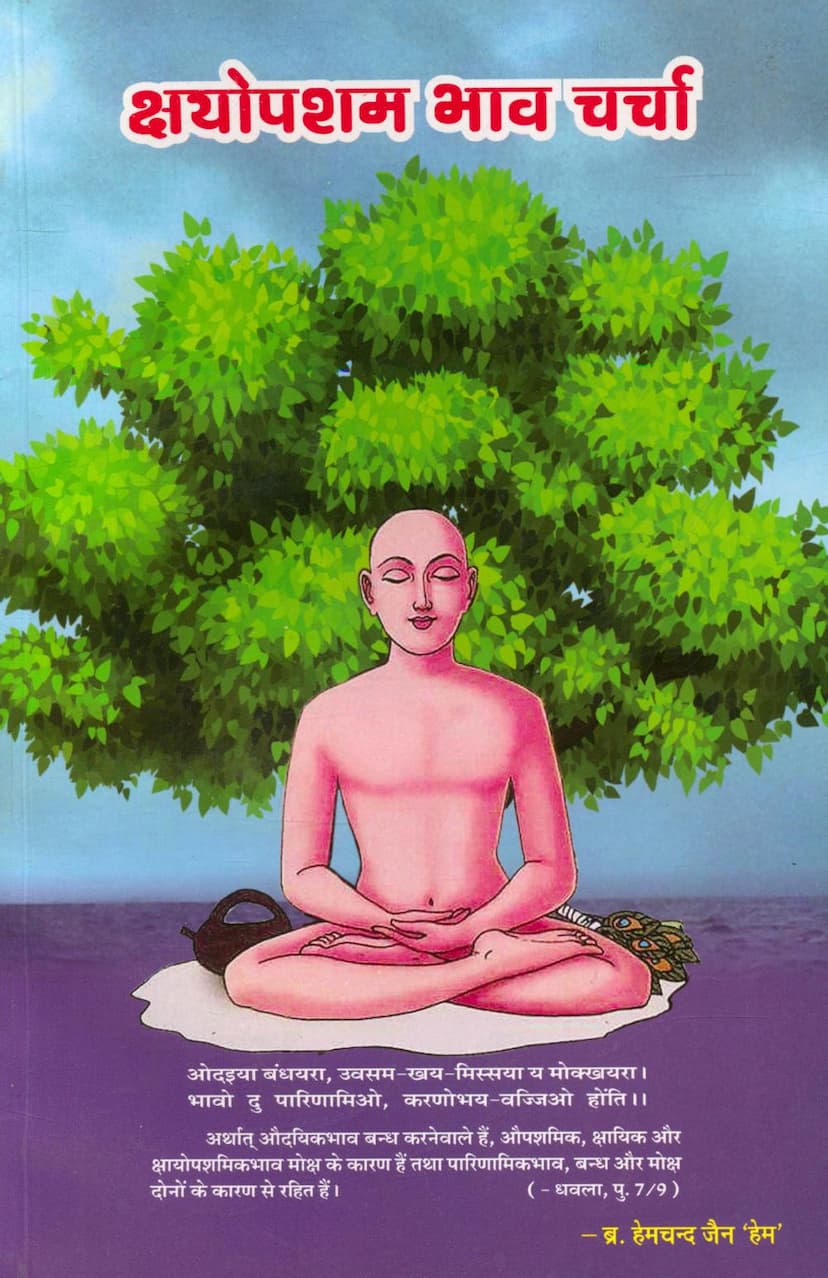Kshayopasham Bhav Charcha
Added to library: September 2, 2025

Summary
This text is a Jain scripture titled "Kshayopasham Bhav Charcha" (Discussion on Kshayopasham Bhav), authored by Bra. Hemchand Jain and edited by Dr. Rakesh Jain Shastri. It was published by Shri Akhil Bharatvarshiya Digambar Jain Vidwat Parishad Trust.
The book delves into the concept of "Kshayopasham Bhav" within Jain philosophy, which is one of the five types of soul states (Bhavas). The core idea, as stated in the initial quote from the Dhavala text, is that:
- Audayik Bhav (Odayik Bhav) leads to bondage.
- Aupashamik, Kshayik, and Kshayopashamik Bhav are causes of liberation (Moksha).
- Parinamic Bhav is neither a cause of bondage nor liberation.
The book is presented as a compilation of discussions and analyses on the Kshayopasham Bhav, illuminated by both ancient Jain scriptures (Agam) and modern spiritual insights (Adhyatm).
The structure of the book includes:
- Publisher's Note: Expressing pleasure in publishing this significant work by Bra. Hemchand Jain and mentioning the trust's plan to publish six important works by him, with "Samayaktva Charcha" and "Kshayopasham Bhav Charcha" already published. It also lists 26 other books published by the trust.
- Editorial Note: Highlighting Bra. Hemchand Jain's contribution to writing on topics where the community faces confusion, and introducing "Kshayopasham Bhav Charcha" as the latest in a series of scholarly publications. It mentions that most of the content was previously published in the "Dharmamangal" magazine and includes articles from other senior scholars.
- "Antar Ki Baat" (A Matter of the Heart/Inner Talk): This section, by Sau. Lilavati Jain, details the genesis of the book. It stemmed from her doubts arising from editorial articles in the "Jinbhashit" magazine in 2007. Her discussions with Bra. Hemchand Jain led to him writing articles to resolve her queries, which were then compiled into this book. She emphasizes the need for such scholarly works to clarify complex topics and invites feedback from scholars for refinement. She also notes that the book focuses solely on Kshayopasham Bhav, unlike a previous publication which had broader content.
- Preface: Dr. Rakesh Jain Shastri's preface elaborates on Kshayopasham Bhav as a "Mishrabhav" (mixed state) encompassing various karmic conditions. He explains how the five Bhavas (Audayik, Aupashamik, Kshayik, Kshayopashamic, Parinamic) are derived from karmic states and how the term "Sannipatik Bhav" arises when multiple Bhavas are present simultaneously.
- Discussions (Charchas): The main body of the book appears to be a series of discussions, likely between Bra. Hemchand Jain and other scholars or spiritual figures, covering various aspects of Kshayopasham Bhav, including:
- Its basis in ancient scriptures (Agam).
- Proper Kshayopashamik Bhav.
- Kshayopashamik Samyagdarshan and Charitra in the light of Agam.
- The nature of Kshayopasham Bhav as described in Dhavala and other texts.
- Discussions on Shubha-Ashubha-Shuddhopayoga based on Shri Pravachansar.
- The process of Punyabandha through Shubhopayoga.
- Discussions on worthy, unworthy, and disqualified recipients (Patra, Apatra, Kupatra).
- The concept of "Akashay Bhav Hi Sachha Dharm" (Absence of Kashaay is True Dharma).
The text includes detailed analysis, scriptural references (from Dhavala, Pravachansar, Purusharthasiddhi Upaya, Tattvartha Sutra, etc.), and points of discussion, often presented in a question-and-answer or dialogue format. It addresses complex doctrinal points, such as the nature of Shubhopayoga, the relationship between Shubhopayoga and Punyabandha, the interpretation of Kshayopashamic Charitra, and the distinction between various types of Samyagdarshan and Charitra.
A significant portion of the book is dedicated to detailed discussions with Acharya Vidyasagarji Maharaj and extensive correspondence, particularly between Dr. Rakesh Jain Shastri and Bra. Hemchand Jain, exploring the nuances of these concepts, with numerous questions and their detailed answers forming the core of the analytical content.
Key Themes and Concepts Discussed:
- Five Bhavas: The foundational concepts of Audayik, Aupashamik, Kshayik, Kshayopashamik, and Parinamic Bhavs are central.
- Kshayopasham Bhav as Mishrabhav: The text emphasizes that Kshayopasham Bhav is a mixed state resulting from the partial destruction (Kshaya), partial suppression (Upsham), and partial origination (Uday) of karmic potentials (spardhakas).
- Shubhopayoga, Ashubhopayoga, Shuddhopayoga: The book extensively analyzes these three types of upayoga (conscious attention) and their relation to different stages of spiritual progress (Gunasthana) and their impact on karmic bondage and liberation.
- Nischay and Vyavahar Naya: The author frequently employs these two perspectives of Jain logic to explain complex doctrines, highlighting how different interpretations arise based on the approach.
- The Role of Kashaaya (Passions): The text underscores the importance of minimizing and ultimately eliminating Kashaayas (anger, pride, deceit, greed) for spiritual progress and liberation.
- Purity of Intention and Practice: The book emphasizes that genuine spiritual progress is based on sincere inner understanding and practice rather than mere external rituals or following others blindly.
- Scholarly Debate and Interpretation: The text reflects a deep engagement with Jain scriptures and a commitment to rigorous analysis, often engaging with differing interpretations and seeking clarity through scriptural evidence.
In essence, "Kshayopasham Bhav Charcha" is a scholarly exploration of a crucial Jain philosophical concept, aiming to provide clarity and guidance to the Jain community on complex spiritual principles, grounding its explanations in both the ancient wisdom of the Agamas and the practical insights of its revered authors and commentators.